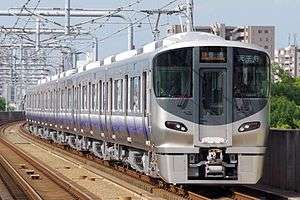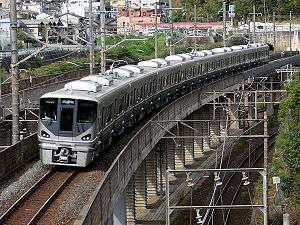225 series
| 225 series | |
|---|---|
|
The first 225-0 series unit delivered, May 2010 | |
| In service | December 2010– |
| Manufacturer | Kawasaki Heavy Industries, Kinki Sharyo |
| Replaced | 103 series, 113 series, 117 series, 205 series, 221 series |
| Constructed | 2010– |
| Number under construction | 16 vehicles on order[1] |
| Number in service | 226 vehicles |
| Formation | 8/6/4 cars per trainset |
| Operator(s) | JR-West |
| Depot(s) | Aboshi, Hineno, Miyahara |
| Line(s) served | Tokaido Main Line, Sanyo Main Line, Kosei Line, Hokuriku Main Line, Akō Line, Osaka Loop Line, Hanwa Line, Kansai Airport Line, Kisei Main Line, Fukuchiyama Line |
| Specifications | |
| Car body construction | Stainless steel[2] |
| Car length |
19,570 mm (64 ft 2 in) (end cars) 19,500 mm (64 ft 0 in) (intermediate cars) |
| Width | 2,950 mm (9 ft 8 in) |
| Floor height | 1,120 mm (3 ft 8 in) |
| Doors | 3 pairs per side |
| Maximum speed |
130 km/h (81 mph) (225-0 series) 120 km/h (75 mph) (225-5000/6000 series)[3] |
| Traction system | Variable frequency (2-level IGBT) |
| Electric system(s) | 1,500 V DC Overhead |
| Current collection method | WPS28C single-arm pantograph |
| Bogies |
WDT63 (powered), WTR246B/WTR246C (trailer)(225-0/6000 series) WDT63A (powered), WTR246D/WTR246E (trailer)(225-5000 series) |
| Braking system(s) | Regenerative brake, electronically controlled pneumatic brakes, snow-resistant brake, parking brake |
| Safety system(s) | ATS-SW2, ATS-P3 |
| Multiple working | 221/223 series |
| Track gauge | 1,067 mm (3 ft 6 in) |
The 225 series (225系 Nihyaku-nijūgo-kei) is a DC electric multiple unit (EMU) train type operated by West Japan Railway Company (JR-West) on suburban services in the "Keihanshin" Kyoto-Osaka-Kobe area since December 2010.[4]
Design
226 vehicles were ordered, at a cost of approximately 30 billion yen.[5] The trains incorporate increased front-end crash protection with the inclusion of crushable zones.[6]
Variants
- 225-0 series
- 225-100 series
- 225-5000 series
- 225-5100 series
- 225-6000 series
The total order of 226 vehicles consists of 110 225-0 series vehicles with a maximum speed of 130 km/h for use on Tokaido Main Line and Sanyo Main Line Special Rapid services and 116 225-5000 series vehicles with a maximum speed of 120 km/h for use on the Hanwa Line.[3] Livery for each is identical to that of the 223 series vehicles on each of these routes.
The first 225-100 series second-batch sets were delivered in early 2016, formed as four- and eight-car units.[7] These were followed by 225-5100 series second-batch sets, also delivered in early 2016, formed as four- and six-car sets.[8]
Operations
225-0/100 series
- Tokaido Main Line (Biwako Line, JR Kyoto Line, JR Kobe Line) (Maibara - Kobe)
- Sanyo Main Line (JR Kobe Line) (Kōbe - Kamigōri)
- Hokuriku Main Line (Biwako Line) (Tsuruga - Maibara)
- Kosei Line (through services from Hokuriku Main Line)
- Kusatsu Line
- Akō Line (Aioi - Banshū-Akō)
225-5000/5100 series (4 cars)
- Osaka Loop Line
- Hanwa Line (through services from Kansai Airport Line)
- Kansai Airport Line
- Kisei Main Line (Kinokuni Line) (Wakayama - Kii-Tanabe)
225-5100 series (6 cars)
225-6000 series
- Tokaido Main Line (JR Kobe Line) (Ōsaka - Amagasaki)
- Fukuchiyama Line (JR Takarazuka Line) (Amagasaki - Sasayamaguchi or Fukuchiyama)
Formations
225-0 series
8-car sets
| Car No. | 1 | 2 | 3 | 4 | 5 | 6 | 7 | 8 |
|---|---|---|---|---|---|---|---|---|
| Designation | M'c | M3 | M' | M' | M5 | M' | M' | Mc |
| Numbering | KuMoHa 224 | MoHa 225-300 | MoHa 224 | MoHa 224 | MoHa 225-500 | MoHa 224 | MoHa 224 | KuMoHa 225 |
| Capacity | 126 | 144 | 144 | 144 | 144 | 144 | 144 | 133 |
| Weight | 41.8 t | 39.5 t | 38.6 t | 38.6 t | 39.0 t | 38.6 t | 38.6 t | 41.6 t |
6-car sets
| Car No. | 1 | 2 | 3 | 4 | 5 | 6 |
|---|---|---|---|---|---|---|
| Designation | M'c | M' | M | M' | M' | Mc |
| Numbering | KuMoHa 224 | MoHa 224 | MoHa 225 | MoHa 224 | MoHa 224 | KuMoHa 225 |
4-car sets
| Car No. | 1 | 2 | 3 | 4 |
|---|---|---|---|---|
| Designation | M'c | M | M' | Mc |
| Numbering | KuMoHa 224 | MoHa 225 | MoHa 224 | KuMoHa 225 |
225-100 series

The 225-100 series sets are formed as eight-car and four-car sets, as follows.[7]
8-car sets
| Car No. | 1 | 2 | 3 | 4 | 5 | 6 | 7 | 8 |
|---|---|---|---|---|---|---|---|---|
| Numbering | KuMoHa 224-1xx | MoHa 225-4xx | MoHa 224-1xx | MoHa 224-1xx | MoHa 225-6xx | MoHa 224-1xx | MoHa 224-1xx | KuMoHa 225-1xx |
4-car sets
| Car No. | 1 | 2 | 3 | 4 |
|---|---|---|---|---|
| Numbering | KuMoHa 224-1xx | MoHa 225-1xx | MoHa 224-1xx | KuMoHa 225-1xx |
225-5000 series
The 225-5000 series sets are formed as follows.[11]
| Car No. | 1 | 2 | 3 | 4 |
|---|---|---|---|---|
| Designation | M'c | M | M' | Mc |
| Numbering | KuMoHa 224-5000 | MoHa 225-5000 | MoHa 224-5000 | KuMoHa 225-5000 |
225-5100 series

The 225-5100 series sets are formed as six-car and four-car sets, as follows.[8]
6-car sets
| Designation | M'c | M' | M | M' | M' | Mc |
|---|---|---|---|---|---|---|
| Numbering | KuMoHa 224-51xx | MoHa 224-51xx | MoHa 225-51xx | MoHa 224-51xx | MoHa 224-51xx | KuMoHa 225-51xx |
4-car sets
| Designation | M'c | M | M' | Mc |
|---|---|---|---|---|
| Numbering | KuMoHa 224-51xx | MoHa 225-51xx | MoHa 224-51xx | KuMoHa 225-51xx |
225-6000 series

6-car sets
| Car No. | 1 | 2 | 3 | 4 | 5 | 6 |
|---|---|---|---|---|---|---|
| Designation | M'c | M' | M | M' | M' | Mc |
| Numbering | KuMoHa 224-6000 | MoHa 224-6000 | MoHa 225-6000 | MoHa 224-6000 | MoHa 224-6000 | KuMoHa 225-6000 |
4-car sets
| Car No. | 1 | 2 | 3 | 4 |
|---|---|---|---|---|
| Designation | M'c | M | M' | Mc |
| Numbering | KuMoHa 224-6000 | MoHa 225-6000 | MoHa 224-6000 | KuMoHa 225-6000 |
Interior
-

General interior view, January 2011
-
2-abreast flip-over seats, December 2010
-

LCD passenger information display
-
Wheelchair-accessible toilet, December 2010
-

An emergency ladder stowage box inside a 225-5100 series set
History
The first 225-0 series 8-car train was delivered from Kinki Sharyo on 18 May 2010.[14] The first pair of 225-5000 series 4-car trains was delivered from Kinki Sharyo on 7 September 2010.[11]
Both the 225-0 and 225-5000 series entered revenue service from 1 December 2010.[15]
References
- ↑ 平成25年春ダイヤ改正について [Spring 2013 timetable revision details] (pdf). JR-West news release (in Japanese). West Japan Railway Company. 21 December 2012.
- ↑ "衝撃を吸収する新型車両完成 脱線事故を教訓に JR西 (JR-West Unveils New Trains with Crash Impact Absorption)". Asahi Shimbun (in Japanese). The Asahi Shimbun Company. 17 May 2010. Archived from the original on 25 May 2010. Retrieved 19 May 2010.
- 1 2 JR西日本225系が完成。 [JR-West 225 series completed] (in Japanese). Neko Publishing. 19 May 2010. Archived from the original on 24 May 2010. Retrieved 21 May 2010.
- ↑ 新型近郊電車225系の展示会の開催について [Details of new 225 series EMU display)] (in Japanese). JR-West. 15 September 2010. Archived from the original on 19 September 2010. Retrieved 16 September 2010.
- ↑ "JR-West rolls out carriages boasting safety 'crush zone'". The Japan Times. Japan. 18 May 2010. Retrieved 19 May 2010.
- ↑ "JR西日本 京阪神エリアに225系直流電車を投入" [JR-West to introduce 225 series DC EMUs in Keihanshin area] (in Japanese). Neko Publishing. 16 September 2009. Retrieved 16 September 2009.
- 1 2 225系増備車 [225 series additional-build sets]. Japan Railfan Magazine (in Japanese). Vol. 56 no. 661. Japan: Koyusha Co., Ltd. May 2016. p. 74-75.
- 1 2 3 225系増備車 [225 series additional-build sets]. Japan Railfan Magazine (in Japanese). Vol. 56 no. 662. Japan: Koyusha Co., Ltd. June 2016. p. 78-79.
- ↑ JR西日本 225系近郊型直流電車 [JR-West 225 series DC suburban EMU]. Tetsudō Daiya Jōhō Magazine. Japan: Kōtsū Shimbun. 39 (315): 70–71. July 2010.
- ↑ 225系近郊形直流電車 [JR-West 225 series DC suburban EMU]. Japan Railfan Magazine. Japan: Kōyūsha. 50 (592): 60–66. August 2010.
- 1 2 225系5000番台が近畿車輛から出場 [225-5000 series delivered from Kinki Sharyo]. Japan Railfan Magazine Online (in Japanese). Koyusha Co., Ltd. 7 September 2010. Archived from the original on 11 September 2010. Retrieved 9 September 2010.
- ↑ 225系6000番台が福知山へ [225-6000 series transferred to Fukuchiyama]. Japan Railfan Magazine Online (in Japanese). Koyusha Co., Ltd. 2 March 2012. Retrieved 2 March 2012.
- ↑ "225系Y2編成が6000番台に" [225 series Y2 set to the level of No. 6000]. Japan Railfan Magazine Online (in Japanese). Koyusha Co., Ltd. 13 March 2012. Retrieved 13 March 2012.
- ↑ 225系が近畿車輛から出場 [225 series delivered from Kinki Sharyo]. Japan Railfan Magazine Online (in Japanese). Koyusha Co., Ltd. 18 May 2010. Archived from the original on 23 May 2010. Retrieved 18 May 2010.
- ↑ "225系が営業運転を開始" [225 series enter revenue service]. Japan Railfan Magazine Online. Koyusha Co., Ltd. 2 December 2010. Retrieved 2 December 2010.
External links
| Wikimedia Commons has media related to 225 series. |
- JR-West CEO's September 2009 report announcing 225 series order (Japanese)
- JR-West news release announcing completion of first set (18 May 2010) (Japanese)
- Kinki Sharyo 225 series information (Japanese)

